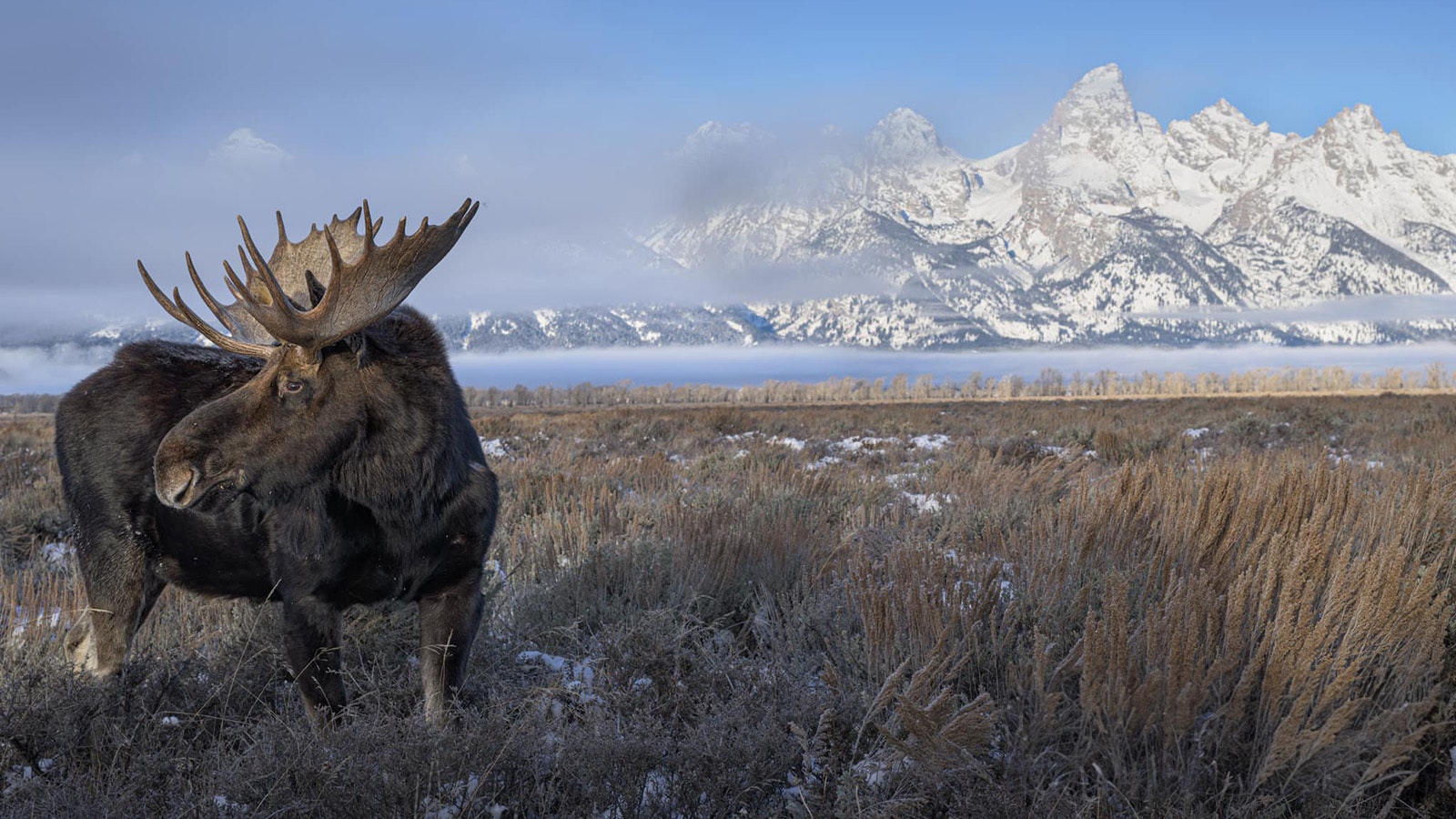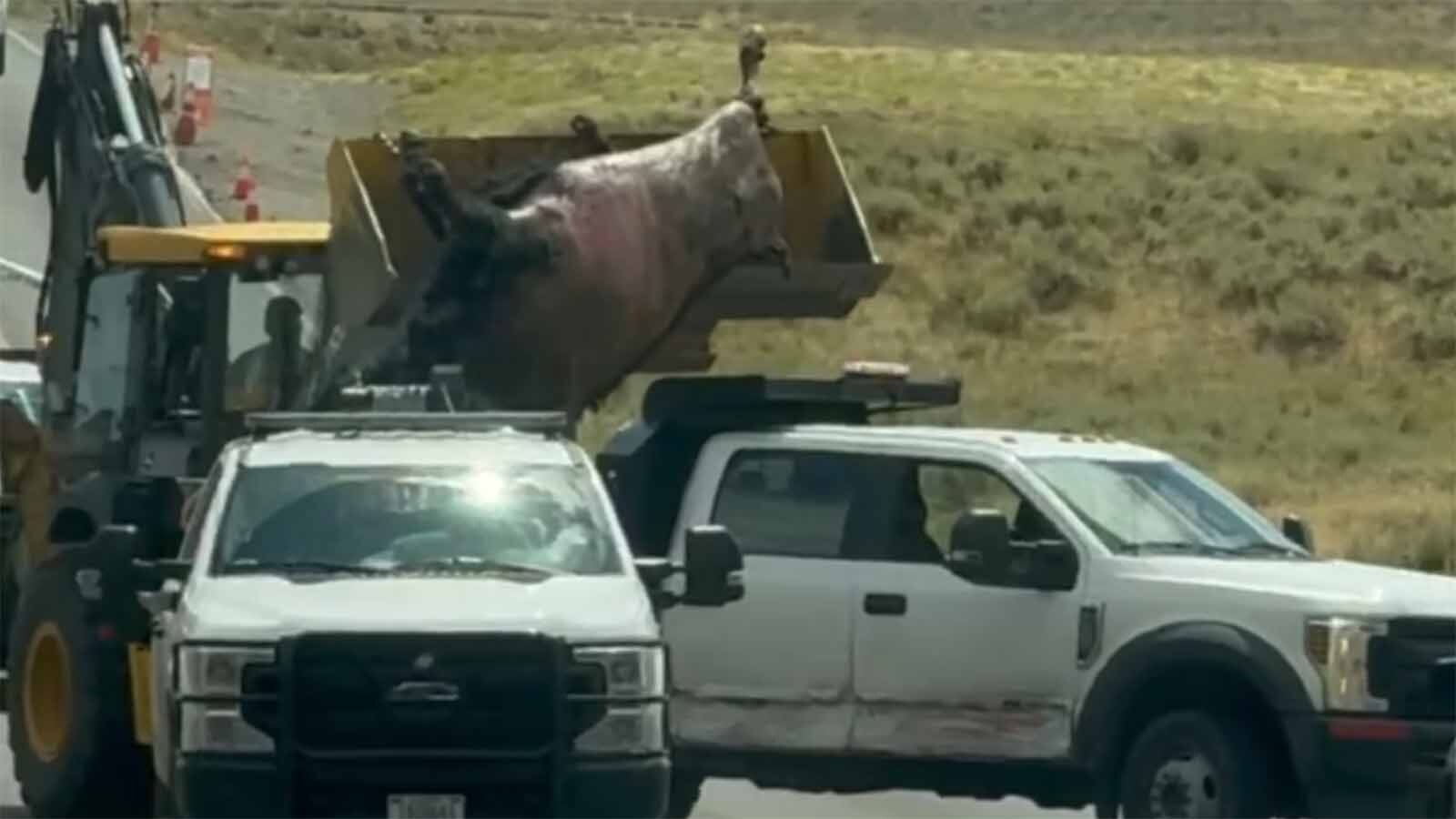Most people would look at landscape and wildlife photographer Anita Wooldridge’s perfect portrait of a large bull moose peering over its shoulder in front of the snow-covered Grandt Tetons and call it “a lucky shot.” And Wooldridge would agree, to an extent.
“People say, ‘Well, you were lucky.’ And it's like part of it is luck,” she told Cowboy State Daily. “That day, it came together. It was a really great experience. But you’ve got to go get it. If you don’t go, you don’t get the shot.”
Wooldridge captured the photo on her first winter visit to Jackson, but it took years of expertise and plenty of day-of effort to capture such a majestic moment.
The Extra Effort
Wooldridge is a Colorado resident who’s been a photographer her whole life. Since her retirement, she’s been able to dive deeper into her hobby.
“It's just always been a passion to capture landscape and wildlife photography,” she said. “And if you can get both settings like that one photo, a picture's worth 1,000 words. I used to do a lot of underwater photography. I have degrees in oceanography. So, that was always a passion for me. But I moved to Colorado in 2012 because the mountains called.”
Despite living in Colorado and its famous section of the Rocky Mountains, Wooldridge said the Grand Tetons and Yellowstone National Park are “two of my favorite places in the world.” She’s made plenty of trips to Wyoming for nature photography, but her last visit provided the first opportunity for winter wildlife photography.
A lack of winter weather and a COVID-afflicted companion altered the first leg of Wooldridge’s winter excursion in Jackson. Then, as her friend recovered, the snow finally arrived and she could immerse herself in the atmosphere she had come for.
“That’s when I found him posing,” she said.
Tactical Moose
Wooldridge likes moose, and there are plenty of them in the Jackson area. Capturing her majestic moose shot took considerable effort and planning, but the results are evident.
For starters, she knew she was in the right place at the right time to find mellower moose. The critters are notorious for having hair-trigger tempers — docile and cool one moment, agitated and aggressive the next.
“The moose this time of year are out of the rut. So, they are in a different mindset. Their brain has gone back into their head,” she said.
She also knew where to find the most moose. The best opportunities for good photos would be near the bitterroot bushes, where the bulls and cows hang out at this time of the winter season.
“They really like bitterroot bush, apparently,” she said. “They need that for digestion (but it has) very little nutritional value. In the Antelope Flats area, there's a lot of this plant. So, they congregate in that area to eat the plants. Everybody knows they hang out in that area.”
Getting there is half the fun. Once Wooldridge found the bitterroot bushes, she identified the two-track roads that could get her closer. The first outing was more than she anticipated.
“I wasn't prepared for my first trip to walk out where I needed to get the shot,” she said. “It’s a little dicey to walk in that kind of stuff. I didn't get the shot I wanted.”
The strategy was sound, but the tactics needed some alterations. She’d be back the next day.
Patience Makes Perfect
On her second outing, Wooldridge got where she needed to go.
“On the next trip, I decided to take my time and meander to where the moose are. That’s where you must go to get a shot with the moose in front of the Tetons and with the right lens,” she said.
The moose were closer than the day before, but her slower approach and respectful distance kept them all calm. Wooldridge said other people were standing in the same area, but everyone were careful and avoided startling the bitterroot-munching moose.
Wooldridge knew the photo she wanted, but didn’t know when her moose moment would manifest in front of her camera. So she watched and waited, letting her moose models determine the shooting schedule.
That’s when “he” wandered into the frame.
“There were several bulls in the area,” she said. “Some were interacting; they will do some antler rattling this time of year because they're trying to get rid of their antlers. Then, they walk off and eat for a while. He just happened to be isolated where I could get him alone and not have others in the same frame.
The perfect image of a bull moose wintering in the Grand Tetons was a short moment that resulted from a healthy amount of planning and preparation. Wooldridge’s effort paid off, but it was no accident.
“I tried several times on several different occasions to get that shot,” she said. “It was going out there many times to try to get the right conditions and have a cooperative subject in front of the Tetons. That made the shot.”
Get The Shot
The moral of Wooldridge’s story is how much foresight, planning and effort it takes to capture the perfect moment on a camera, one everyone looks at and says, “Boy, you got lucky.”
She’ll be the first to admit there was an element of luck to her majestic moose mountain photo, but she made most of her luck.
A quote falsely attributed to Thomas Jefferson says, “I’m a great believer in luck. The harder I work, the more luck I have.” Regardless of who said it (most likely writer Coleman Cox in the 1920s), it’s Wooldridge’s tried-and-true key to successful wildlife photography.
“As a photographer, if you don't go out, you don't get the shot,” she said. “The more you go out and are in the area, the more likely you are to see what you want to take a picture of. You can get lucky on a given day and just happen to be there and say, ‘Oh, wow, that's great.’
“But some people work for a shot and go out day after day and hope they’re there when it comes together. And that day, it came together.”
Finding luck is more challenging than finding the perfect moose photo, but even Wooldridge would admit she got lucky during that trip. After her moose moment, she was fortunate enough to be in the area where an orphaned black bear cub was found stuck in a tree.
Wooldridge got incredible images of the unfortunate black bear, but the story had a happy ending. The cub was rescued by Idaho Black Bear Rehab, where she will reside until she can return to the wild in spring.
“That was an experience for me because it was maybe once in a lifetime,” she said.
Any photographer or tourist would call that a lucky break. Regardless, Wooldridge’s message for any aspiring wildlife photographer remains the same.
“You’ve got to go get it,” she said. “If you don’t go, you don’t get the shot.”
Andrew Rossi can be reached at arossi@cowboystatedaily.com.





